16.7E: Exercícios para a Seção 16.7
- Page ID
- 188524
Nos exercícios 1 a 6, sem usar o teorema de Stokes, calcule diretamente o fluxo de\(curl \, \vecs F \cdot \vecs N\) sobre a superfície dada e a integral de circulação em torno de seu limite, assumindo que todos estão orientados no sentido horário.
1. \(\vecs F(x,y,z) = y^2\,\mathbf{\hat i} + z^2\,\mathbf{\hat j} + x^2\,\mathbf{\hat k}\);\(S\) é a primeira porção octante do plano\(x + y + z = 1\).
2. \(\vecs F(x,y,z) = z\,\mathbf{\hat i} + x\,\mathbf{\hat j} + y\,\mathbf{\hat k}\);\(S\) é hemisfério\(z = (a^2 - x^2 - y^2)^{1/2}\).
- Resposta
- \(\displaystyle \iint_S (curl \, \vecs F \cdot \vecs N) \, dS = \pi a^2\)
3. \(\vecs F(x,y,z) = y^2\,\mathbf{\hat i} + 2x\,\mathbf{\hat j} + 5\,\mathbf{\hat k}\);\(S\) é hemisfério\(z = (4 - x^2 - y^2)^{1/2}\).
4. \(\vecs F(x,y,z) = z\,\mathbf{\hat i} + 2x\,\mathbf{\hat j} + 3y\,\mathbf{\hat k}\);\(S\) é o hemisfério superior\(z = \sqrt{9 - x^2 - y^2}\).
- Resposta
- \(\displaystyle \iint_S (curl \, \vecs F \cdot \vecs N) \, dS = 18 \pi\)
5. \(\vecs F(x,y,z) = (x + 2z)\,\mathbf{\hat i} + (y - x)\,\mathbf{\hat j} + (z - y)\,\mathbf{\hat k}\);\(S\) é uma região triangular com vértices\((3, 0, 0), \, (0, 3/2, 0),\) e\((0, 0, 3).\)
6. \(\vecs F(x,y,z) = 2y\,\mathbf{\hat i} + 6z\,\mathbf{\hat j} + 3x\,\mathbf{\hat k}\);\(S\) é uma porção do parabolóide\(z = 4 - x^2 - y^2\) e está acima do\(xy\) plano.
- Resposta
- \(\displaystyle \iint_S (curl \, \vecs F \cdot \vecs N) \, dS = -8 \pi\)
Nos exercícios 7 a 9, use o teorema de Stokes\(\displaystyle \iint_S (curl \, \vecs F \cdot \vecs N) \, dS\) para avaliar os campos vetoriais e a superfície.
7. \(\vecs F(x,y,z) = xy\,\mathbf{\hat i} - z\,\mathbf{\hat j}\)e\(S\) é a superfície do cubo\(0 \leq x \leq 1, \, 0 \leq y \leq 1, \, 0 \leq z \leq 1\), exceto pela face onde\(z = 0\) e usando a unidade externa do vetor normal.
8. \(\vecs F(x,y,z) = xy\,\mathbf{\hat i} + x^2 \,\mathbf{\hat j} + z^2 \,\mathbf{\hat k}\); e\(C\) é a interseção do parabolóide\(z = x^2 + y^2\) com o plano\(z = y\), usando o vetor normal externo.
- Resposta
- \(\displaystyle \iint_S (curl \, \vecs F \cdot \vecs N) \, dS = 0\)
9. \(\vecs F(x,y,z) = 4y\,\mathbf{\hat i} + z \,\mathbf{\hat j} + 2y \,\mathbf{\hat k}\); e\(C\) é a interseção da esfera\(x^2 + y^2 + z^2 = 4\) com o plano\(z = 0\) e usando o vetor normal externo.
10. Use o teorema de Stokes para avaliar\(\displaystyle \int_C \big[2xy^2z \, dx + 2x^2yz \, dy + (x^2y^2 - 2z) \, dz\big],\) onde\(C\) está a curva dada por\(x = \cos t, \, y = \sin t, \, 0 \leq t \leq 2\pi\), percorrida na direção do aumento\(t.\)
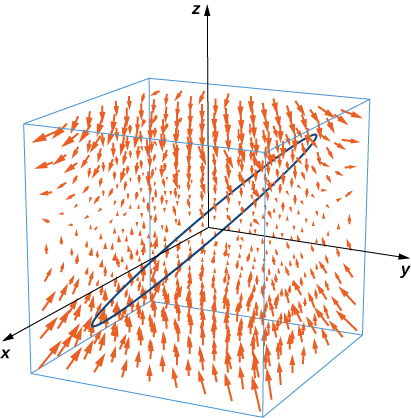
- Resposta
- \(\displaystyle \int_C \vecs F \cdot dS = 0\)
11. [T] Use a computer algebraic system (CAS) and Stokes’ theorem to approximate line integral \(\displaystyle \int_C (y \, dx + z \, dy + x \, dz),\) where \(C\) is the intersection of plane \(x + y = 2\) and surface \(x^2 + y^2 + z^2 = 2(x + y)\), traversed counterclockwise viewed from the origin.
12. [T] Use a CAS and Stokes’ theorem to approximate line integral \(\displaystyle \int_C (3y\, dx + 2z \, dy - 5x \, dz),\) where \(C\) is the intersection of the \(xy\)-plane and hemisphere \(z = \sqrt{1 - x^2 - y^2}\), traversed counterclockwise viewed from the top—that is, from the positive \(z\)-axis toward the \(xy\)-plane.
- Answer
- \(\displaystyle \int_C \vecs F \cdot dS = - 9.4248\)
13. [T] Use a CAS and Stokes’ theorem to approximate line integral \(\displaystyle \int_C [(1 + y) \, z \, dx + (1 + z) x \, dy + (1 + x) y \, dz],\) where \(C\) is a triangle with vertices \((1,0,0), \, (0,1,0)\), and \((0,0,1)\) oriented counterclockwise.
14. Use Stokes’ theorem to evaluate \(\displaystyle \iint_S curl \, \vecs F \cdot dS,\) where \(\vecs F(x,y,z) = e^{xy} cos \, z\,\mathbf{\hat i} + x^2 z\,\mathbf{\hat j} + xy\,\mathbf{\hat k}\), and \(S\) is half of sphere \(x = \sqrt{1 - y^2 - z^2}\), oriented out toward the positive \(x\)-axis.
- Answer
- \(\displaystyle \iint_S \vecs F \cdot dS = 0\)
15. [T] Use a CAS and Stokes’ theorem to evaluate \(\displaystyle \iint_S (curl \, \vecs F \cdot \vecs N) \, dS,\) where \(\vecs F(x,y,z) = x^2 y\,\mathbf{\hat i} + xy^2 \,\mathbf{\hat j} + z^3 \,\mathbf{\hat k}\) and \(C\) is the curve of the intersection of plane \(3x + 2y + z = 6\) and cylinder \(x^2 + y^2 = 4\), oriented clockwise when viewed from above.
16. [T] Use a CAS and Stokes’ theorem to evaluate \(\displaystyle \iint_S curl \, \vecs F \cdot dS,\) where \(\vecs F(x,y,z) = \left( \sin(y + z) - yx^2 - \dfrac{y^3}{3}\right)\,\mathbf{\hat i} + x \, \cos (y + z) \,\mathbf{\hat j} + \cos (2y) \,\mathbf{\hat k}\) and \(S\) consists of the top and the four sides but not the bottom of the cube with vertices \((\pm 1, \, \pm1, \, \pm1)\), oriented outward.
- Answer
- \(\displaystyle \iint_S curl \, \vecs F \cdot dS = 2.6667\)
17. [T] Use a CAS and Stokes’ theorem to evaluate \(\displaystyle \iint_S curl \, \vecs F \cdot dS,\) where \(\vecs F(x,y,z) = z^2\,\mathbf{\hat i} + 3xy\,\mathbf{\hat j} + x^3y^3\,\mathbf{\hat k}\) and \(S\) is the top part of \(z = 5 - x^2 - y^2\) above plane \(z = 1\) and \(S\) is oriented upward.
18. Use Stokes’ theorem to evaluate \(\displaystyle \iint_S (curl \, \vecs F \cdot \vecs N) dS,\) where \(\vecs F(x,y,z) = z^2\,\mathbf{\hat i} + y^2\,\mathbf{\hat j} + x\,\mathbf{\hat k}\) and \(S\) is a triangle with vertices \((1, 0, 0), \, (0, 1, 0)\) and \((0, 0, 1)\) with counterclockwise orientation.
- Answer
- \(\displaystyle \iint_S (curl \, \vecs F \cdot \vecs N)dS = -\dfrac{1}{6}\)
19. Use Stokes’ theorem to evaluate line integral \(\displaystyle \int_C (z \, dx + x \, dy + y \, dz),\) where \(C\) is a triangle with vertices \((3, 0, 0), \, (0, 0, 2),\) and \((0, 6, 0)\) traversed in the given order.
20. Use Stokes’ theorem to evaluate \(\displaystyle \int_C \left(\dfrac{1}{2} y^2 \, dx + z \, dy + x \, dz \right),\) where \(C\) is the curve of intersection of plane \(x + z = 1\) and ellipsoid \(x^2 + 2y^2 + z^2 = 1\), oriented clockwise from the origin.
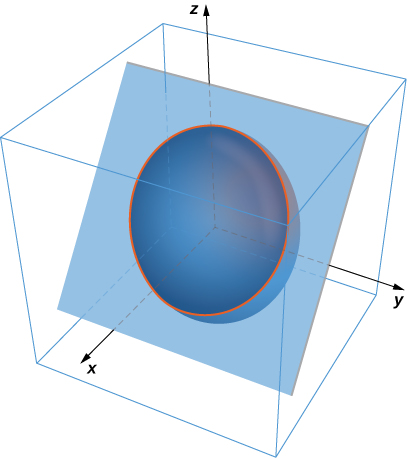
- Resposta
- \(\displaystyle \int_C \left(\dfrac{1}{2} y^2 \, dx + z \, dy + x \, dz \right) = - \dfrac{\pi}{4}\)
21. Use o teorema de Stokes para avaliar\(\displaystyle \iint_S (curl \, \vecs F \cdot \vecs N) dS,\) onde\(\vecs F(x,y,z) = x\,\mathbf{\hat i} + y^2\,\mathbf{\hat j} + ze^{xy}\,\mathbf{\hat k}\) e\(S\) é a parte da superfície\(z = 1 - x^2 - 2y^2\) com\(z \geq 0\), orientada no sentido anti-horário.
22. Use o teorema de Stokes para campo vetorial\(\vecs F(x,y,z) = z\,\mathbf{\hat i} + 3x\,\mathbf{\hat j} + 2z\,\mathbf{\hat k}\) onde\(S\)\(C\) é superfície\(z = 1 - x^2 - 2y^2, \, z \geq 0\)\(x^2 + y^2 = 1\), é círculo limite e\(S\) é orientado na\(z\) direção positiva.
- Resposta
- \(\displaystyle \iint_S (curl \, \vecs F \cdot \vecs N)dS = -3\pi\)
23. Use o teorema de Stokes para campo vetorial\(\vecs F(x,y,z) = - \dfrac{3}{2} y^2\,\mathbf{\hat i} - 2 xy\,\mathbf{\hat j} + yz\,\mathbf{\hat k}\), onde\(S\) é a parte da superfície do plano\(x + y + z = 1\) contida dentro de um triângulo\(C\) com vértices\((1, 0, 0), \, (0, 1, 0),\) e\((0, 0, 1),\) percorrida no sentido anti-horário, conforme visto de cima.
24. \(2x + 2y + z = 1\)Sabe-se que um certo caminho fechado\(C\) no plano se projeta\(x^2 + y^2 = 1\) em um círculo unitário no\(xy\) plano. \(C\)Seja uma constante e deixe\(\vecs R(x,y,z) = x\,\mathbf{\hat i} + y\,\mathbf{\hat j} + z\,\mathbf{\hat k}\). Use o teorema de Stokes para avaliar\(\displaystyle \int_C(c \,\mathbf{\hat k} \times \vecs R) \cdot dS.\)
- Resposta
- \(\displaystyle \int_C (c \,\mathbf{\hat k} \times \vecs R) \cdot dS = 2\pi c\)
25. Use o teorema de Stokes e\(C\) seja o limite da superfície\(z = x^2 + y^2\) com\(0 \leq x \leq 2\) e\(0 \leq y \leq 1\) orientado com o normal voltado para cima. Defina\(\vecs F(x,y,z) = \big(\sin (x^3) + xz\big) \,\mathbf{\hat i} + (x - yz)\,\mathbf{\hat j} + \cos (z^4) \,\mathbf{\hat k}\) e avalie\(\int_C \vecs F \cdot dS\).
26. \(S\)Seja o hemisfério\(x^2 + y^2 + z^2 = 4\) com\(z \geq 0\), orientado para cima. \(\vecs F(x,y,z) = x^2 e^{yz}\,\mathbf{\hat i} + y^2 e^{xz} \,\mathbf{\hat j} + z^2 e^{xy}\,\mathbf{\hat k}\)Seja um campo vetorial. Use o teorema de Stokes para avaliar\(\displaystyle \iint_S curl \, \vecs F \cdot dS.\)
- Resposta
- \(\displaystyle \iint_S curl \, \vecs F \cdot dS = 0\)
27. \(S\)Seja\(\vecs F(x,y,z) = xy\,\mathbf{\hat i} + (e^{z^2} + y)\,\mathbf{\hat j} + (x + y)\,\mathbf{\hat k}\) e seja o gráfico da função\(y = \dfrac{x^2}{9} + \dfrac{z^2}{9} - 1\) com\(z \leq 0\) orientação para que o vetor normal\(S\) tenha um componente y positivo. Use o teorema de Stokes para calcular integral\(\displaystyle \iint_S curl \, \vecs F \cdot dS.\)
28. Use o teorema de Stokes para avaliar\(\displaystyle \oint \vecs F \cdot dS,\) onde\(\vecs F(x,y,z) = y\,\mathbf{\hat i} + z\,\mathbf{\hat j} + x\,\mathbf{\hat k}\) e\(C\) está um triângulo com vértices\((0, 0, 0), \, (2, 0, 0)\) e\(0,-2,2)\) orientado no sentido anti-horário quando visto de cima.
- Resposta
- \(\displaystyle \oint \vecs F \cdot dS = -4\)
29. Use a integral da superfície no teorema de Stokes para calcular a circulação do campo\(\vecs F,\)\(\vecs F(x,y,z) = x^2y^3 \,\mathbf{\hat i} + \,\mathbf{\hat j} + z\,\mathbf{\hat k}\) em torno da\(C,\) qual está a interseção do cilindro\(x^2 + y^2 = 4\) e do hemisfério\(x^2 + y^2 + z^2 = 16, \, z \geq 0\), orientada no sentido anti-horário quando vista de cima.
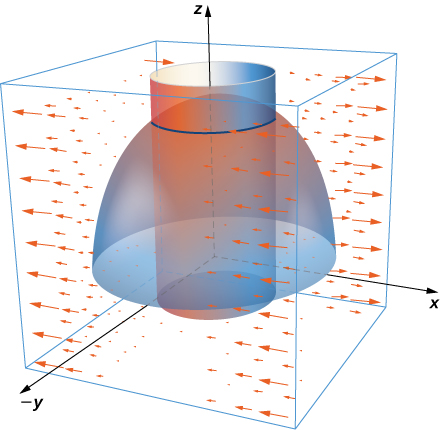
30. Use o teorema de Stokes para calcular\(\displaystyle \iint_S curl \, \vecs F \cdot dS.\) where \(\vecs F(x,y,z) = \,\mathbf{\hat i} + xy^2\,\mathbf{\hat j} + xy^2 \,\mathbf{\hat k}\) and \(S\) is a part of plane \(y + z = 2\) inside cylinder \(x^2 + y^2 = 1\) and oriented counterclockwise.
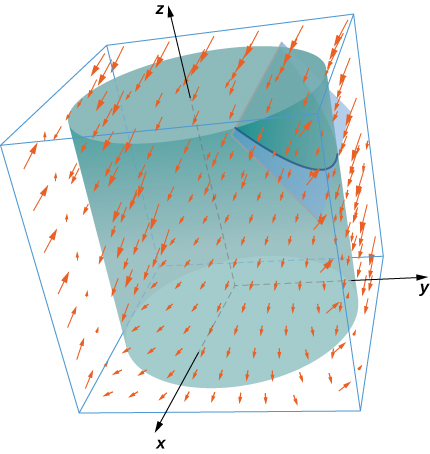
- Resposta
- \(\displaystyle \iint_S curl \, \vecs F \cdot dS = 0\)
31. Use o teorema de Stokes para avaliar\(\displaystyle \iint_S curl \, \vecs F \cdot dS,\) onde\(\vecs F(x,y,z) = -y^2 \,\mathbf{\hat i} + x\,\mathbf{\hat j} + z^2\,\mathbf{\hat k}\) e\(S\) é a parte do plano\(x + y + z = 1\) no octante positivo e orientado no sentido anti-horário\(x \geq 0, \, y \geq 0, \, z \geq 0\).
32. Seja\(\vecs F(x,y,z) = xy\,\mathbf{\hat i} + 2z\,\mathbf{\hat j} - 2y\,\mathbf{\hat k}\) e deixe\(C\) ser a interseção do plano\(x + z = 5\) e do cilindro\(x^2 + y^2 = 9\), que é orientada no sentido anti-horário quando vista de cima. Calcule a integral da linha de\(\vecs F\) over\(C\) usando o teorema de Stokes.
- Resposta
- \(\displaystyle \iint_S curl \, \vecs F \cdot dS = -36 \pi\)
33. [T] Use um CAS e deixe\(\vecs F(x,y,z) = xy^2\,\mathbf{\hat i} + (yz - x)\,\mathbf{\hat j} + e^{yxz}\,\mathbf{\hat k}\). Use o teorema de Stokes para calcular a integral da superfície da curvatura\(\vecs F\) sobre a superfície\(S\) com orientação interna consistindo em um cubo\([0,1] \times [0,1] \times [0,1]\) com o lado direito ausente.
34. \(S\)Seja\(\dfrac{x^2}{4} + \dfrac{y^2}{9} + z^2 = 1\) orientado por elipsoides no sentido anti-horário e\(\vecs F\) seja um campo vetorial com funções componentes que tenham derivadas parciais contínuas.
- Resposta
- \(\displaystyle \iint_S curl \, \vecs F \cdot \vecs N = 0\)
35. \(S\)Seja a parte do parabolóide\(z = 9 - x^2 - y^2\) com\(z \geq 0\). Verifique o teorema de Stokes para o campo vetorial\(\vecs F(x,y,z) = 3z\,\mathbf{\hat i} + 4x\,\mathbf{\hat j} + 2y\,\mathbf{\hat k}\).
36. [T] Use um teorema de CAS e Stokes para avaliar\(\displaystyle \oint \vecs F \cdot dS,\) se\(\vecs F(x,y,z) = (3z - \sin x) \,\mathbf{\hat i} + (x^2 + e^y) \,\mathbf{\hat j} + (y^3 - \cos z) \,\mathbf{\hat k}\), onde\(C\) está a curva dada por\(x = \cos t, \, y = \sin t, \, z = 1; \, 0 \leq t \leq 2\pi\).
- Resposta
- \(\displaystyle \oint_C \vecs F \cdot d\vecs{r} = 0\)
37. [T] Use um teorema de CAS e Stokes para avaliar\(\vecs F(x,y,z) = 2y\,\mathbf{\hat i} + e^z\,\mathbf{\hat j} - \arctan x \,\mathbf{\hat k}\) com\(S\) como uma porção do parabolóide\(z = 4 - x^2 - y^2\) cortada pelo\(xy\) plano -orientado no sentido anti-horário.
38. [T] Use um CAS para avaliar parametricamente por\(\displaystyle \iint_S curl (F) \cdot dS,\) onde\(\vecs F(x,y,z) = 2z\,\mathbf{\hat i} + 3x\,\mathbf{\hat j} + 5y\,\mathbf{\hat k}\) e\(S\) é a superfície\(\vecs r(r,\theta) = r \, \cos \theta \,\mathbf{\hat i} + r \, \sin \theta \,\mathbf{\hat j} + (4 - r^2) \,\mathbf{\hat k} \, (0 \leq \theta \leq 2\pi, \, 0 \leq r \leq 3)\).
- Resposta
- \(\displaystyle \iint_S curl (F) \cdot dS = 84.8230\)
39. \(S\)Seja parabolóide\(z = a (1 - x^2 - y^2)\), pois\(z \geq 0\), onde\(a > 0\) está um número real. Deixe\(\vecs F(x,y,z) = \langle x - y, \, y + z, \, z - x \rangle\). Para que valor (es) de\(a\) (se houver)\(\displaystyle \iint_S (\vecs \nabla \times \vecs F) \cdot \vecs n \, dS\) tem seu valor máximo?
Para os exercícios de aplicação 40 a 41, o objetivo é avaliar\(\displaystyle A = \iint_S (\vecs \nabla \times \vecs F) \cdot \vecs n \, dS,\) onde\(\vecs F = \langle xz, \, -xz, \, xy \rangle\) e\(S\) está a metade superior do elipsoide\(x^2 + y^2 + 8z^2 = 1\), onde\(z \geq 0\).
40. Avalie uma integral de superfície sobre uma superfície mais conveniente para encontrar o valor de\(A.\)
- Resposta
- \(\displaystyle A = \iint_S (\vecs \nabla \times \vecs F) \cdot \vecs n \, dS = 0\)
41. Avalie\(A\) usando uma integral de linha.
42. Pegue o parabolóide\(z = x^2 + y^2\)\(0 \leq z \leq 4\), para e corte-o com avião\(y = 0\). \(S\)Seja a superfície que permanece por\(y \geq 0\), incluindo a superfície plana no\(xz\) plano. \(C\)Seja o semicírculo e o segmento de linha que delimitavam a tampa do\(S\) plano\(z = 4\) com orientação anti-horária. Deixe\(\vecs F = \langle 2z + y, \, 2x + z, \, 2y + x \rangle\). Avalie\(\displaystyle \iint_S (\vecs \nabla \times \vecs F) \cdot \vecs n \, dS.\)
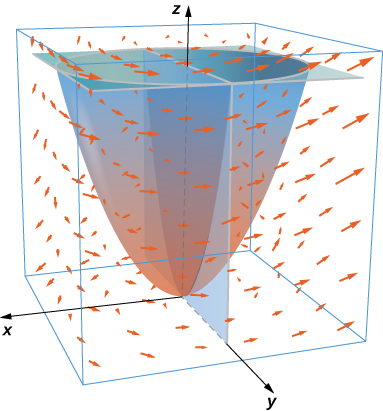
- Resposta


